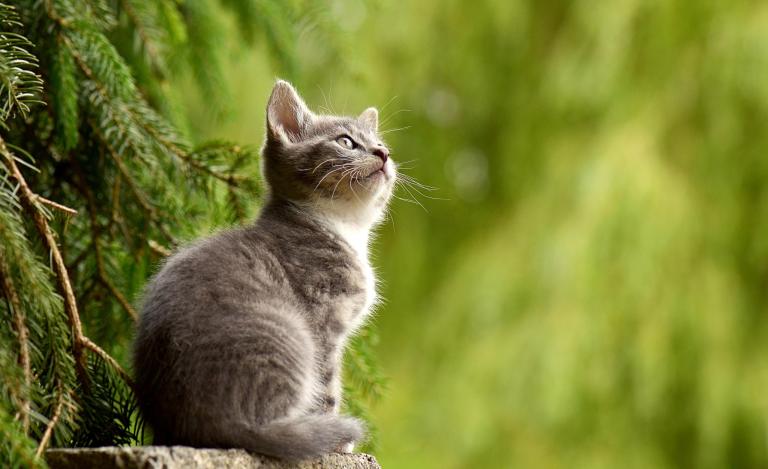
“The animals possess a soul and men must love and feel solidarity with our smaller brethren. All animals are fruit of the creative action of the Holy Spirit and merit respect and they are as near to God as men are.” – Pope John Paul II.
In part one of this exposition, I began my argument that at least some non-human animals possess spiritual souls that are immortal. I defined the various types of souls and contrasted the soul and the body.
In part two, I will argue that those attributes associated with a spiritual soul exist in at least some non-human animals. In order to do so, it will be necessary to show that at least some non-human animals possess powers associated with a spiritual soul. Typically, these powers include free will, intentionality, and a sophisticated level of cognition.
Cats, Dogs, and Heaven
The first question to be addressed is whether non-human animals possess free will. It seems prudent to begin with a definition of free will. The theologian, Father John Hardon provides the essential definition, “The power of the will to determine itself and to act of itself, without compulsion from within or coercion from without.” (Father John Hardon, Modern Catholic Dictionary).
The task then is to show that at least some non-human animals possess the power to “determine [for] itself and to act [for] itself from within [that is, instinctively] or coercion from without [that is, deterministically].”
There is compelling evidence of just this capacity in non-human animals. As Dr. Christian List of the Ludwig Maximilian University of Munich observes, “Chimps don’t have the same agential capacities as humans, but they arguably meet the requirements of agency [The capacity to act independently]. Our best theories of their behavior may well attribute to them the ability to make choices, together with a certain level of control over those choices. They may then count as having a certain kind of free will. Similar things might be said – to a lesser extent – about other mammals.” (Scientific American, June 3, 2019).
The Wolf and Saint Francis
Lest we view this subject strictly as philosophical, there is Saint Francis, the patron Saint of animals. Perhaps the most famous account is Saint Francis’s interaction with a wolf. While Saint Francis was staying in Gubbio, Italy, he learned of a wolf that was attacking people. This had led villagers to become afraid to leave the city walls.
Saint Francis, however, decided to go out and meet the wolf. Saint Francis called out to the creature: “Come to me, Brother Wolf. In the name of Christ, I order you not to hurt anyone.” At that moment, the wolf lowered its head and laid down at Saint Francis’ feet. Saint Francis explained to the wolf that he had been terrorizing the people, killing animals and humans who are made in the image of God. “Brother Wolf,” said Francis, “I want to make peace between you and the people of Gubbio. They will harm you no more and you must no longer harm them. All past crimes are to be forgiven.”
The wolf showed its assent by moving its body and nodding its head. Then, to the gathering crowd’s absolute surprise, Saint Francis asked the wolf to make a pledge. As Saint Francis extended his hand to receive the pledge, the wolf extended its front paw and placed it into the saint’s hand. Then Saint Francis commanded the wolf to follow him into town to make a peace pact with the townspeople. The wolf meekly followed Saint Francis. (From “Taming the Wolf Institute”).
It is very convenient to view this story as metaphorical, but if one accepts that all things are made by God (John 1:3), then we should not dismiss this, and many other similar accounts in the life of Saint Francis, out of hand.
For our purposes, the story of Saint Francis and the wolf demonstrates that the wolf possessed enough free will to cooperate with Saint Francis.
Intentionality
Within the subset of philosophy known as phenomenology, intentionality is defined as “the nature of thoughts to be directed toward or about objects. To speak of the intentional content of a thought is to speak of the mode or way in which a thought is about an object.” (Edmund Husserl).
For example, one may think about God, or one may think about a unicorn. In the first instance, the object of the thought is grounded in reality. In the second instance, the concept does not have an existential import (unicorns do not exist), but the concept of a unicorn is present in the mind in much the same way that the concept of God is. Every thought is about something.
Since concepts are not composed of matter (your thoughts do not take up space), by definition, intentionality and concepts are spiritual.
By its nature, intentionality is subjective. Still, evidence for intentionality in non-human animals can be inferred from observation.
While it is undoubtedly true that instincts provide non-human animals (and humans) with a range of goals, aims, and behaviors, the animal is often on its own as to how to pursue goals. For example, instinct will compel a cat to groom and to hunt. The individual cat must, however, decide which to do and when.
As Helen Steward, professor of philosophy of mind at the University of Leeds points out, the more complex the animal, the greater the freedom of action. Yet even spiders appear to possess the capacity for forward planning, for spatiotemporal awareness, for the maintenance of intention over a significant amount of time, and in the absence of continuous perception of the desired object. (Jumping Spider Tricksters: Deceit, Predation, and Cognition by Stim Wilcox and Robert Jackson).
All of this is to suggest that many non-human animals demonstrate for-thought and intentionality in their lives.
Cognition
The final criterion for a spiritual soul is cognition. The American Psychological Association defines cognition as “all forms of knowing and awareness, such as perceiving, conceiving, remembering, reasoning, judging, imagining, and problem-solving.”
Examples of cognition have been observed in bees, who use their direction relative to the sun to locate food (See the Waggle dance, Nature education 2012). Honey bees have shown the capacity to form mental or cognitive maps. That is, honey bees are able to conceptualize their location and even use shortcuts to return home if they are displaced (See Menzel et al., 2005).
Birds, reptiles, amphibians, and mollusks have also been shown to orient themselves based on the earth’s magnetic field (See Lohmann & Lohmann 1993).
Octopuses will construct barriers around their homes to guard against potential predators or put coconut shells together to make temporary shelters. This behavior is considered tool use and is associated with “higher” thinking animals (The Soul of an Octopus: A Surprising Exploration into the Wonder of Consciousness, Atria Books, 2015).
Furthermore, as Dr. Jill Sackman, head of the behavioral medicine service at BluePearl Veterinary Partners, points out, the brain of a cat is very similar structurally to humans and functions in a like manner as well. Cats are capable of experiencing the passing of time, count (at least up to three), and dream. Cats also possess excellent memories, storying memories for up to ten years (See the work of Mikel Delgado, Ph.D.).
The point of these examples is to imply that at least some non-human animals possess the capacity for conceptual content. That is, they can conceive of abstractions. In this context, that which is abstract is not composed of matter and is, therefore, spiritual. (See Bermúdez, José and Arnon Cahen, “Nonconceptual Mental Content”, The Stanford Encyclopedia of Philosophy [Summer 2020 Edition], Edward N. Zalta [ed.]).
The Bible on Animals
Lastly, the philosophical arguments enumerated above are supported Biblically. Isaiah’s prophecy that, “The wolf will live with the lamb, the leopard will lie down with the goat, the calf and the lion and the yearling together” suggests that the Kingdom of God does include non-human animals. And again in Revelation 5:13 we read, “Then I heard every creature in heaven and on earth and under the earth and on the sea, and all that is in them, saying: To him who sits on the throne and to the Lamb be praise and honor and glory and power, forever and ever!”
The purpose of this exposition is to argue that at least some non-human animals possess spiritual souls. As the great Biblical tradition shows, the spiritual soul is not destroyed by the death of the body. I hope that I have shown that some non-human animals possess a spiritual soul. Thus, it may be said that for them, as for us, death is not the end.












